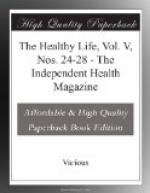In order to examine a food thoroughly, for the purpose of ascertaining if it can be advantageously introduced for consumption, whether albumins, fats, hydrate of carbon, or sugar, etc., or again an association of these principles in a composite article of food are in question, divers researches must be carried out before giving a final judgment.
If a more or less complex article of food is in question, before considering it as a good nutriment, its centesimal composition, or its immediate composition, should be established; its theoretic calorific power should be known, and it should be measured if this has not yet been done.
Besides the calorific yield thus estimated in vitro, the real utilisation in the human organism of articles of food alone or mixed with other foods should be determined, taking simultaneously into account their effects, whether tonic, stimulating or depressing.
From a different point of view it is no longer allowable to neglect before judging whether such and such a nutritive substance is advantageous, the valuation of what we have called, with Prof. Landouzy, the economic yield—that is to say, the price of the energy, provided by the unity of weight of the article of food.
It is only in reviewing “vegetal” substances, taking these divers titles into consideration, that we shall be justified in attributing to the practice of “vegetalism,” integral or mitigated, its definite value.
IV
Only a few years ago, when Schuetzenberger, emulator and forerunner of Fischer, Armand Gautier, Kossel, first disjointed the albuminoid molecule, to examine one by one its divers parts, the composition of the various albumins was very little known. Whether, therefore, albumins of the blood, or those of meat or eggs, were in question, these bodies were hardly ever separated, except through physical circumstances, amongst others by constant quantities of different coagulation. As to the centesimal formula and the intimate structure of the different protoid substances, they could be considered as closely brought together.
From this fact, the physiological problem of the utilisation of albumin was simpler. No matter which article of food contained this albumin, its nutritive power by unity of weight remained the same. At the present time the number of albumins is no longer limited. It is not now physical characteristics founded difficult separations which arbitrarily distinguish those bodies from each other. The individuality of each of the albumins results from its formula of deterioration, under the influence of digestive ferments, or of chemical bodies acting in a similar way, as do mineral acids and alkalis. For want of constituary formula this methodical deterioration makes known the number of molecules (acids or other bodies) which are responsible for the structure of




